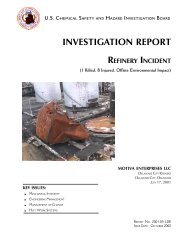CTA Report, Draft 1, ISP Review - US Chemical Safety and Hazard ...
CTA Report, Draft 1, ISP Review - US Chemical Safety and Hazard ...
CTA Report, Draft 1, ISP Review - US Chemical Safety and Hazard ...
Create successful ePaper yourself
Turn your PDF publications into a flip-book with our unique Google optimized e-Paper software.
B.4 Propagating Brush Discharge Ignition Test<br />
During the h<strong>and</strong>ling of bulk powders, a propagating brush discharge may ignite dust. A sufficient charge<br />
built up on the powder surface can break down in the form of a propagating brush discharge. Unlike a<br />
spark discharge, which is localized between two conductive points, a propagating brush discharge is a<br />
surface phenomenon. Consequently, it poses the potential hazard of being a delocalized multipoint<br />
ignition source. The force of the charge breakdown is sufficient to disperse dust deposited on the surface<br />
into the air.<br />
B.4.1 Test Setup <strong>and</strong> Procedure<br />
The test apparatus consisted of a high-voltage power supply (Hipotronics Model 250D) connected to a<br />
multipoint corona generator. The base of the apparatus was an 8.5-inch sheet metal disk, which is<br />
connected to the ground. An 8.5- by 11-inch plastic sheet, with a thickness of 0.0075 inch, was placed on<br />
top of the disk.<br />
A grounded 2-inch-diameter ball electrode was used to initiate the propagating brush discharge. To<br />
estimate the energy of the discharge, a Monroe Electronics Model 282 electrostatic fieldmeter was used to<br />
measure the change in electrostatic field (i.e., electrical potential of the surface by extension) before <strong>and</strong><br />
after the discharge.<br />
To produce a charge on the surface of the plastic sheet, 30 to 50 kilovolts were supplied to the multipoint<br />
corona generator centered over the sheet metal disk surface at a height of 25.4 millimeters. After a<br />
charging time of 60 seconds, the generator was moved away from the surface of the plastic sheet <strong>and</strong> the<br />
power supply was turned off.<br />
The field meter was positioned above the surface of the plastic sheet to measure the electrostatic field.<br />
The spherical grounding electrode was then lowered to the plastic surface. A propagating brush discharge<br />
was produced as the electrode was lowered but before it touched the surface.<br />
107









